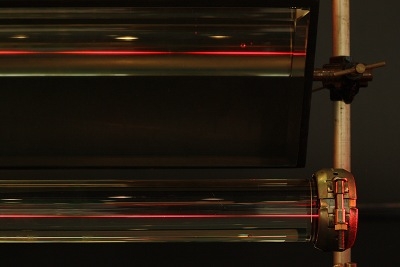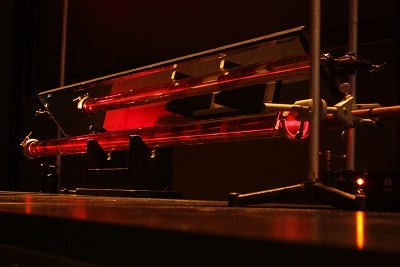What it shows:
Linearly polarized light, propagating down a long glass tube filled with corn syrup, is made to rotate its direction of polarization by the optically active corn syrup. The intensity of the 90° scattered light varies dramatically, in a periodic manner, along the length of the tube -- the intensity being zero when the dipole radiators oscillate in the line of sight direction, and maximum intensity when they oscillate perpendicular to the line of sight. Scattered light is most intense when the electric field vector is perpendicular to the line of sight.



How it works:
A 6-foot long (≈ 1.8 m) by 2" (5.1 cm) I.D. glass sewer pipe is filled with Karo™ Corn Syrup. 1 One end is sealed with a black rubber stopper (to minimize reflections) and the other end has been fitted and sealed with a glass disk window. A linearly polarized laser 2 serves as the light source. When one views the tube from the side, the laser beam seems to be periodically modulated in intensity.
The optical activity of sugar syrups has been discussed in the writeup for the Sugar Syrups demonstration. Suppose vertically polarized light is incident on the tube as depicted above. The light scattered out of the beam (towards the audience) is maximum (from the audience point of view). As the beam propagates down the tube, its polarization direction is continuously rotated, and by the time it has undergone a 90° rotation, the light scattered out of the beam towards the audience is minimal because the optical oscillators are vibrating horizontally with their dipole axes in the direction of the audience. A 180° rotation restores the vertical orientation and the scattered light is once again maximum ... and so on down the tube for a total of six complete rotations. This turns out to be about 12.5° rotation/cm, or 31.8° per inch.
That the intensity of the scattered light depends upon the point of view (with respect to the dipole oscillators) can be demonstrated by positioning a long mirror above the tube, tilted at a 45° angle. The audience then simultaneously sees the horizontally scattered light as well as the light scattered in the vertical direction (as seen in the mirror). The two intensities are out of phase--when light is scattered maximally in the horizontal direction it is minimal in the vertical direction and vice versa. This is all neatly explained with the dipole radiators model.
Setting it up:
The long glass pipe is supported by two v-shaped wooden blocks on top of the lecture bench. Also on the bench is the 35 mW HeNe laser, which too is quite long (42"), so total bench-top space must be reckoned with. The long mirror is supported at the ends by 1/2" diameter rods held by standard lab-clamps and can be rotated. Lecture hall lights need to be turned off. To avoid confusion, it's best to start with the mirror facing backward (it's painted black on the back) so that the audience can first concentrate on what's happening in the glass pipe alone. It can later be rotated to the appropriate angle so that the audience can get a top-view of the pipe and compare the scattering intensity with the straight-on view.
Comments:
As described in the previous demonstration, the polarization rotation is a dispersive effect. Thus, when polarized white light is used, 3 a spiral rainbow of colors is produced, somewhat like a rainbow barber-shop pole. Unhappily, the colors are not brilliant (the reds and blues are most noticeable) and, due to lack of intensity, the effect is visible only in the first foot or so (of the tube). The laser demonstration was first published by W.S. Moore 4 using acetic acid and sodium thiosulphate; pre-laser demonstrations of this effect, using sugar or corn syrup, have been around for a long time. 5
1 The tube holds about 4 liters when full. A few ml of Consan Triple Action 20 (algaecide, fungicide, bactericide), available at most garden centers, have been added to the corn syrup to retard spoilage.
2 Our laser of choice is a 35 mW HeNe (Spectra Physics model 127-35) because it is bright and easy to use. Our 120 mW Argon laser is of course even brighter and dramatic but its disadvantages are noise, warm-up time (and tuning), cool-down time, and bulk. A small 2 mW laser is pitifully weak for this demonstration and not recommended.
3 A slide projector with a polarizing filter in front of the lens works adequately -- use a slide with a circular aperture in it and rack the lens way out to produce a more or less collimated beam.
4 W.S. Moore, Am J Phys 39, 1536-1537, (1971). "A Multipurpose Laser Demonstration Experiment"
5 See R.M. Sutton, Demonstration Experiments in Physics, (McGraw-Hill, NY, 1938) p. 425 "L-129 Rotation of Plane of Polarization by Sugar Solution," for example.